|
FAQs about Stony Coral Health/Disease/Pests 14
Related Articles: Coral Pests and Disease; pests, predators,
diseases and conditions by Sara Mavinkurve,
Quarantine of Corals
and Invertebrates, LPS
Corals, True or Stony Corals, Order
Scleractinia, Propagation for Marine
Aquarium Use,
Related FAQs: Stony Coral Disease 1, Stony Coral Disease 2, Stony Coral Disease 3, Stony Coral Disease 4, Stony Coral Disease 5, Stony Coral Disease 6, Stony Coral Disease 7, Stony Coral Disease 8, Stony Coral Disease 9, Stony Coral Disease 10,
Stony Coral Disease 11, Stony Coral Disease
12, Stony Coral Disease 13,
Stony Coral Disease 15,
FAQs on Stony Coral Disease by Category: Diagnosing:
Environmental (Pollution/Poisoning, Lighting...),
Nutritional, Social (Allelopathy),
Trauma,
Pathogenic (Infectious, Parasitic, Viral)
Predatory/Pest,
Treatments
FAQs on Stony Coral Disease by Family: Acroporid Disease, Acroporid Disease 2, Acroporid Disease 3, Acroporid Disease 4..., Caryophyllid Disease, Caryophyllid Disease 2..., Elegance Coral Disease/Pests, Dendrophylliid Disease, Faviid Disease, Faviid Disease 2, Fungiid Disease, Mussid Disease, Mussid Health 2, Poritid Health, Trachyphylliid Disease, Trachyphyllia Disease 2,
FAQs on Stony Coral Disease by Type: Brown Jelly Disease, RTN,
|
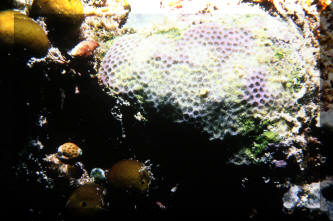
Diseases of stony corals occur in all the same
categories as other organism groups: Environmental, Nutritional, Trauma,
Social, Infectious and Parasitic. Here is a mal-afflicted colony in
Mabul, Malaysia.
|
Just the Duncan, Torch and Frogspawn? Cnid. hlth.
3/3/20
WWM,
The aquarium is a 90-gallon breeder, mixed reef, with Acros, Cactus,
Blastos, Zoos, Galaxy, Rhodactis and Acans all doing great (growing,
good color).
However, Torch, Hammer and Duncan corals are all not expanding and the
Duncan is receding. Temperature is consistently at 77°, phosphates are
0.25
(Red Sea test kit) nitrates are 20, SG 1.027 Calcium 440, DKH 11 –
<Water parameters seem to be fine>
four power heads (generally moderate flow) —— I dose with Red Sea
products (Coral Pro Salt) and AquaVitro (Fuel, Calcium, 8.4).
<How often do you change water and how much each time?>
I feed Reef Roids and Oyster Feast. The tank has a Foxface, Kole Tang,
clown fish, damsels, and electric blue and scarlet hermit crabs. in
addition, a few brittle stars and sea urchins. What parameters would
cause a Duncan, Torch and Hammer coral to slowly recede/deteriorate,
while the others mentioned above are growing and expanding fully and
have good color??
<Water parameters may not be the reason of your corals deterioration;
since the rest of the corals are thriving, it may be something else...
sometimes certain corals don’t “like” where they have been placed,
either because of the water flow on that particular place or the
illumination they are receiving. I also think that maybe some of your
fish, (perhaps the Foxface) could be nipping at them.>
Thanks, WWM
<Cheers. Wil.>
Re: Just the Duncan, Torch and Frogspawn?
3/4/20
Thanks for the response
<Welcome>
Regarding water changes they are not very frequent, about every three
weeks.
<And what is the percentage each water change?>
Regarding filtration, I run Phosfiltrum and Purfiltrum, a little higher
than the manufacturers recommended amount for the volume of water and a
protein skimmer.
<Even though these are very good products, I wouldn't rely solely on
them, water changes have proven to be the best way to export
nutrients and replace beneficial elements required by living organisms
to thrive. Wil.>
Just the Duncan, Torch and Frogspawn? Cnid. hlth.
3/3/20
WWM,
The aquarium is a 90-gallon breeder, mixed reef, with Acros, Cactus,
Blastos, Zoos, Galaxy, Rhodactis and Acans all doing great (growing,
good color).
However, Torch, Hammer and Duncan corals are all not expanding and the
Duncan is receding. Temperature is consistently at 77°, phosphates are
0.25
(Red Sea test kit) nitrates are 20, SG 1.027 Calcium 440, DKH 11 –
<Water parameters seem to be fine>
four power heads (generally moderate flow) —— I dose with Red Sea
products (Coral Pro Salt) and AquaVitro (Fuel, Calcium, 8.4).
<How often do you change water and how much each time?>
I feed Reef Roids and Oyster Feast. The tank has a Foxface, Kole Tang,
clown fish, damsels, and electric blue and scarlet hermit crabs. in
addition, a few brittle stars and sea urchins. What parameters would
cause a Duncan, Torch and Hammer coral to slowly recede/deteriorate,
while the others mentioned above are growing and expanding fully and
have good color??
<Water parameters may not be the reason of your corals deterioration;
since the rest of the corals are thriving, it may be something else...
sometimes certain corals don’t “like” where they have been placed,
either because of the water flow on that particular place or the
illumination they are receiving. I also think that maybe some of your
fish, (perhaps the Foxface) could be nipping at them.>
Thanks, WWM
<Cheers. Wil.>
|
Moray Eels and Coral
/BobF 9/14/19
Hello Crew,
<Iishan>
Does the mucus from moray eels inhibit coral growth?
<Mmm; have not come across such statements... Marco?>
I have a 32 gallon aquarium with live rock, live sand, a small eel and four SPS
corals. WWM
crew identified this eel as a Gymnothorax australicaola many years ago. It is
about 8 or 9 inches long. The corals are two Montipora and two Acropora.
<Stony corals, Acroporids in this case, are easily influenced by metabolite
accumulation...>
I am trying to learn why the corals are dying. If the water chemistry, lighting
and temperature are OK, could the eel be causing a problem for the corals? I
feed it a small fish about once every two weeks. The nitrate and phosphate
levels are undetectable.
<Numbers please, for what you mention, lighting, feeding>
I have a professional do maintenance on the aquarium once a month and he does
not know why the corals are dying. He suggested that the mucus could be the
problem.
Thank you,
Iishan
<Possibly... Bob Fenner>
Moray Eels and Coral /Wil
9/14/19
Hello Crew,
<Hello Iishan, Wil this morning>
Does the mucus from moray eels inhibit coral growth?
<Not usually>
I have a 32 gallon aquarium with live rock, live sand, a small eel and four SPS
corals.
<Not the ideal water volume, do you have a sump-refugium?>
WWM crew identified this eel as a Gymnothorax australicaola <australicola> many
years ago.
It is about 8 or 9 inches long. The corals are two Montipora and two Acropora.
I am trying to learn why the corals are dying. If the water chemistry,
lighting and temperature are OK, could the eel be causing a problem for the
corals?
<The only thing that I’d blame the eel for, is that it may be toppling the
corals while swimming or at feeding time and this may be stressful for your
SPS.>
I feed it a small fish about once every two weeks. The nitrate and phosphate
levels are undetectable.
<Do you have a good protein skimmer? Eels are messy eaters that produce a lot of
waste so, frequent water changes are required to guarantee the cleanliness of
the water needed by corals, especially in reduced water volumes.>
I have a professional do maintenance on the aquarium once a month and he does
not know why the corals are dying. He suggested that the mucus could be the
problem.
<I don’t think the mucus produced by the eel is the reason of the inhibited
coral growth, if your lighting, nitrates and phosphates are adequate, it must
likely be an alkalinity and/or calcium issue, what are the levels on both?...
you didn’t mention the ph level either.>
Thank you, Iishan
<You're welcome. Wil.>
|

 |
|
Re: Moray Eels and Coral 9/17/19
Sorry for the delayed reply, Bob! I am not aware of any negative impact of moray
eel mucus on coral growth and have seen stunning systems with corals and moray
eels, although those tanks were large and heavily filtrated. I suspect water
quality and/or microbiology being the culprit here. Cheers, Marco.
<Thank you Marco; this is the experience Wil and I related. Cheers, BobF>
|
|
Dying Acan coral... no useful input 1/7/19
Hi!,
<Richard>
I have several Acan corals, one of which began dying on me a month or so ago. It
is slowly dying back, and I have not been able to find anything causing it.
<Umm; a description of your system, maintenance practices, supplements used,
livestock... water quality tests, what you've done to date... not only helpful,
but absolutely necessary to help you. Am/we're not mind readers>
Today I pulled it, and using a scalpel, cut away some of the dying "flesh" to
see if something was burrowing under it and doing the damage. What I found was
many small clumps of what almost looks like a fungi. I am attaching a pic with
the fungus area showing some of this. It is not present above the living tissue,
only under it. Is there anything to be done for this?
Have a great day and thank you.
Richard
<Uhh, see WWM, respond to the above. Bob Fenner>
|
 |
SPS issues. 5/31/18
Hello again Bob, hope this finds you well. I was wondering if you could
weigh in on something for me. Over the last few weeks I’ve had issues
with a few colonies of my Aussie Acros. In one case a colony of
highlighter Acro about 6”x6” started bleaching from the bottom up very
slowly.
The bleaching was kinda odd because the demarcation line was perfectly
uniform across the whole bottom of the colony and worked its way up
keeping uniformity. I had to pull it and frag it to save some. So far
the frags seem to be ok.
<Good>
Something that I am noticing is that most of my Acros don’t seem to have
the vibrant colors they used to. They seem to be pale and muted color.
My chemistry is as follows
CA 475
<Too high, esp. in rel. to [Mg]>
Nitrates 0
<Likely NO2>
Nitrates 0
<... absolutely necessary>
PO 4 is undetectable
<Also essential>
Alk 10 dkh (just won’t go lower with my reactor)
PH 7.8-8.0
<A little low... I'd shoot for 8.2 on the low side>
Salinity 1.025
Mag 1300
ORP 390 (ozone)
Temp 77-78
And I run Radions from 7am to 6pm at 90% intensity.
<Do you have access to a PAR or PUR meter? Need values at the depth of
your Acroporas>
My flow is adequate. Several wave makers and power heads. Can you think
of anything that I could be missing?
<The above; most likely nutrient starvation>
Anything I can be testing for? I was wondering if maybe I have low
potassium?
<Unlikely>
I don’t have a test kit to check it yet. I will have one in the next
couple days.
As always, thank you.
John
<I'd either be feeding more or adding chemical feeds for NO3 and HPO4.
Bob Fenner>
Re: SPS issues. 5/31/18
Thank you Bob. Do you have any nutrient feeding suggestions other than
overfeeding the tank? Any product you prefer?
John
<Mmm; well... as this is a purposely public forum, I am wont to not
state caution... Because you have a large volume/system, you are a
candidate for direct chemical dosing... There ARE nutrient supplements
one can either mix up (DIY) or buy commercially... and administer drop
wise on a tested, daily basis. However, again, if it were me, mine, I'd
add more foods... live, frozen/defrosted, dried-prepared TILL you had a
few ppm of Nitrate and a few hundreds of ppm of soluble Phosphate. Is
this satisfying? Bob Fenner>
Re: SPS issues. 6/1/18
I read you loud and clear. More food it is. Thank you Bob.
<Welcome John. Do please keep me/us informed re your Acropora health,
measurable nutrient levels. BobF>
Re: SPS issues. 6/1/18
Sure will Bob. Thanks again.
<Cheers mate>
|
corals dying; General input in, general output out
6/30/17
<5.6 megs...>
Help
Rich here
<RMF here>
My corals are dying. I have a 180 gallon setup that has been running for six
years. It was FOWLR and some inverts: hermits, cleaner shrimp, small
snails. Last Fall I put two live rocks with anthelia in the tank. They did
great. slowly, over six months, I added a few mushrooms, Zoanthids, trumpets,
Duncan branch colony, a dragon soul and an Acan lord. Everything was
doing fine, growing, until I added a mummy eye chalice from a LFS.
<Mmm; could be just coincidence>
My water parameters are stable: zero ammonia and nitrites, nitrates 2 ppm, ph
8.2, temp 77 degrees, KH 11, calcium 420.
<Have some HPO4? About three times [Mg] than Calcium?>
Three sicci circulation pumps in the main display, and reef breeders led lights.
I do 20% water changes every 10 to 14 days with RODI water.
The mummy eye had a small area on it that looked like some of the "skin" was
starting to peel. I should have never bought it. Over about three weeks it
started to die off . I brought it back to the LFS and they cut off the dying
parts and dipped it.
<Worth trying>
After going back in the tank it continued to die off over a few days. It was
removed, and now, about six weeks later, a Zoa garden that I have had for seven
months, my Acan and dragon soul are all going thru the same process. I am also
starting to see some small patches of green algae in the tank for the first
time. I have attached two pics.
I think I waited too long for the Acan but I need help to save what I can. Any
suggestions? Thanks you.
<The usual "punting" ideas of overdosing iodide-ate, use of simple sugar
(glucose likely). All gone over on WWM. See the search tool (on every page), or
learn to/use the indices. The large/r issue/s could involve some other aspect/s
of water quality, "something" missing critically, simple/r allelopathy... there
are a few approaches to discounting these... Massive water changes/almost
clean-outs, use of chemical filtrants, addition of refugiums/sumps with massive
DSBs, macroalgal culture on RDP... So; a bunch to state that cannot be easily
re-keyed daily.
Bob Fenner>
|
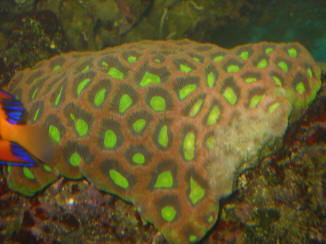
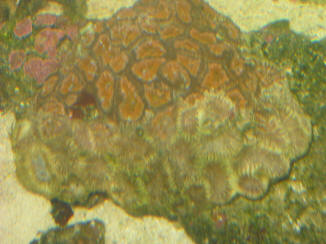 |
|
Coral bleaching? 6/24/17
Hi,
<Hello Richard>
I am finally turning to the Gurus of all things marine with this question.
When I purchased this coral it was smaller, and the original growth was the same
color/texture that it is now. However, all new growth seems to be "bleached". I
started this coral at the bottom of my tank, and while growth
was slow, it did grow, but began to exhibit this "bleaching". After a few months
I moved it up and finally placed it at the top of the rock structure in my tank.
It began to grow a bit quicker, but still shows this bleached tissue. As it is
all down at the bottom, I don't believe it is from too much light, that would
obliviously effect the top the most, so I cannot figure anything out. The only
guess I have is that this is new tissue that will eventually grow enough
Zooxanthellae which will cause the tissue to form colors more like the original
tissue.
Am I wrong and something else is happening?
<Your logic seems plausible... Might there be a/n organism/s bothering this
coral? I'd check with a flashlight during the night at times.>
Thanks for all of the help.
RM
<Thank you for sharing. Bob Fenner>
|
 |
Please help. Cnid. allelopathy in a new, large sys.
5/26/16
Hello Mr. Fenner,
<Hey Dai>
I hope you can point me in the right direction. I have a 265 gallon reef
tank that I set up 4 months ago. I have sump/refugium, 4" carbon
reactor, 6" media reactor with media pellets, 8" skimmer. Lights are 4 Hydra 26
HDs.
Nitrate /phosphate is zero
<Mmm; stop here: You know that all bio-mineralizing life requires "some" NO3 and
HPO4? W/o these basic chemical nutrients all your "corals" will be very
stressed/starved>
and the water is within reef parameters. The tank has 3 sections. Left
is Zoas, center is 100 plus heads of hammers/frogspawn, and the right is 18"
green leather and 4" green toadstool.
<Yeeikes....>
Everything was fine with Zoas multiplying, hammers sprouts tiny babies but
within the past 5 days, some of the hammer heads just died leaving stalk
white skeletons.
<The "losers"... to either the Alcyoniids or Zoanthids>
I bought a 60 gallon so this weekend I can put the finger/toadstool in it.
I hook up the FX6 filter (400 GPH) with carbon to address chemical warfare since
Monday. I think the reasons on the demise of the hammers are :
1. Chemical release from leather/toadstool.
<Possibly>
2. Media reactor strips all nitrate/phosphate which hammers do need to grow.
<Definitely a/some factor>
So my plan is:
1. Move the toadstool/green finger to the 60 gallon.
<Okay>
2. Discontinue the FX6.
<All-right>
3. Discontinue the carbon and media reactor (all in one pellets).
<Sounds good>
The Zoas are thriving with new heads forming every week. I love to have a garden
of hammers and while some people grow these like weeds, I can't keep them alive.
Before dying, they thrive then die next day. Is my diagnosis and plan of action
correct? Thank you Mr. Fenner. Dai
<I do agree with your plan; is what I would do, try at this point. IF no
improvement, I would move the Euphyllias elsewhere. DO PLEASE READ AND HEED my
acclimation protocol for introducing any/all NEW Cnidarians... by mixing water
to/fro twixt the main-display and isolation/quarantine system. HERE:
http://www.wetwebmedia.com/CorlCompArt.htm
Bob Fenner>
<<Note: next time mention triple-dosing iodide-ate>>
Re: Please help
Thank you Mr. Fenner. So you are saying maybe it is the Zoas that are affecting
the hammers as well ?
<Might/could well be; yes>
In that case should I move the hammers to the 60 and leave the toadstool/finger
in the main tank?
<Yes; a better plan... Plus I'd triple dose all (both systems) with
iodide-ate... every three days, three times>
Or just leave them in the main tank for now? I bought the 60 for the leathers
specifically. Is it OK to run the 4" carbon reactor?
<Can't say from here. I would NOT use such on a newish system period>
On another topic. I think the" all in one pellets" give people the false sense
of security.
<Oh yeah; the/a "western ethic"... trained to be good consumers... "Buying"
something... but sans understanding, often false notion/s>
The dealer touts as " zero nitrate and zero phosphate" so people go crazy
thinking they don't have to do water for a year. But while this is true, it is
hurting corals because it is stripping of the essential nutrients that corals
need.
<Yes... even other media/sources tout that the world's reefs are "nutrient free"
when in good shape. NOT the case. They are nutrient concentrated; with the life
there scavenging most all available. NEVER zero nutrients in the water>
If you have to rely on these 'miracles" to get nitrate/PO4 to be zero then that
person needs to evaluate his technique of husbandry.
<Very well stated>
Thank you and I look forward to your guidance. Dai
<And I to your further sharing. BobF>
Re: Please help 5/27/16
Ok, so this is the plan. Move the hammers to the 60. How much of new water to
old water ratio be?
<About half>
If the old water is not good (chemical warfare, no nutrients) then may be start
with 100% fresh water?
<Not I>
You talk about triple dose 2 tanks but I am not familiar with the medication.
You mean every three days, I dose the tank 3 times a day and for how long? Is
this the iodine coral dip?
<See WWM re. B>
Thanks! Dai
|
STN issue on Acros 4/13/16
Hello Bob and Crew,
<Howdy Tann>
Thank you in advanced. I have a two part issue unfortunately.
<Go ahead>
The first issue is in regards to my SPS frag tank. I have a
48"x48"x12" frag tank that I've had for about a year now. I like to
grow out my corals before placing them in my display.
<Neat>
I have changed from 4x Radion G2 to 8x T5s 4 weeks ago, because I
was having trouble getting good coloring and I've heard that T5s would be
better for this issue. Therefore I wanted to try it out myself. I originally
had the T5s 16" above my water line, and then last week I moved it down to
12".
<Mmm; do/did you measure PAR/PUR before the switch, on install and lowering
the current fixture?>
The top of my large colonies are about 5" below the waterline and I'm
getting par at about 210 now (10% increase although I think my apogee par
meter is not calibrated correctly so it may be giving me false readings).
<Ahh; I see>
Recently I've noticed better coloring, but also STN at the base of 4 of my
corals just a couple days ago. Including my largest colony of Bali shortcake
Acros which is about 10"x6" large. I've attached photos for you to see.
<I see them>
My parameters are as follows and they’ve been pretty stable:
Alk: 8.9
Cal: 410
Mag: 1380
Salinity 1.27
Temp 76-79
Phosphate: I've been getting separate readings on my Red Sea test and on my
digital Hanna checker test. I'm not sure which one to trust as they both
greatly vary in readings.
<But.... there IS some detectable HPO4 I trust>
Do you think it's the lighting?
<This is the most reasonable; recent change>
Should I leave it in place or do a dip in iodide with glucose and lower
salinity?
<I would add the iodide (triple dose every three days, three times) to the
system, as well as the sugar; and lower the spg a thousandth>
The second is issue is with Cyano, which could be affecting the Acros I was
talking about.
<Yes; or vice versa... the condition, whatever is allowing the apparent STN
may be fostering BGA growth>
I've been battling a bad case of Cyano as well for the last 4-5 months
and I haven't been able to pinpoint the problem. I do bi-weekly water
changes of 20% and I also run a phosphate remover.
<I'd remove this... for now.>
I have 3x EcoTech mp40 Vortechs for flow running at 30%. At first I thought
it was my eggcrate, as I read that some of them leech phosphate and
other chemicals.
<? Not as far as I'm aware... they're Styrene>
So I spray painted new ones with paint suited for aquariums. Could it be the
Cyano that's affecting the Acros?
<It could be; yes>
It mostly covers the eggcrate and any rock, but they also cover the edges of
where the Acros encrust. I've attached some photos, you can even see some on
the base of the Acro that's bleaching.
Any advice would be greatly appreciated for the bleaching and the Cyano.
Thanks
again.
<As stated, the treatment in place, removing the GFO (I take it) and
patience. Do report back. Bob Fenner>
|
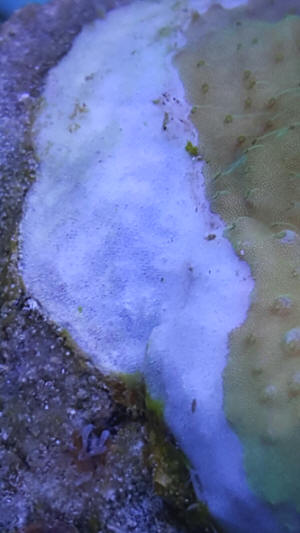

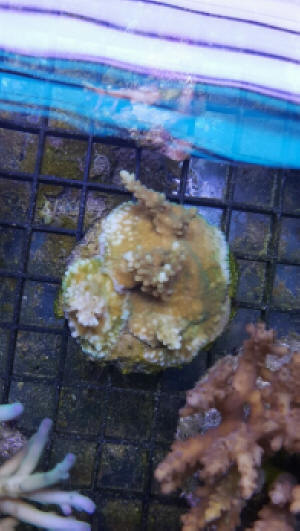
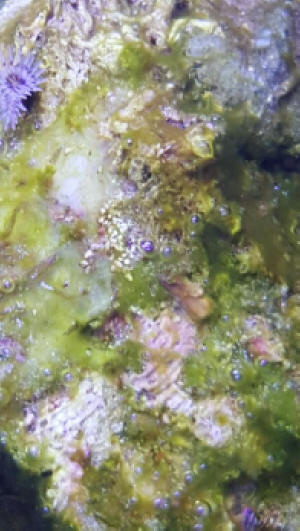 |
|
Re: STN issue on Acros... clarification/repetition, and reading
4/15/16
Hello Bob,
<Ave Tann>
Thank you for getting back to me so quickly. Yesterday I had dipped the
effected corals in iodide, with glucose and I lowered the spg. I was getting
a very high readings around .09 on the Hanna checker, but zero on the Red
Sea Test (I've ran the test many times).
<? Readings... of what? Phosphate?>
Therefore I don't know which one to trust since I have so much Cyano.
<The BGA may well be scavenging, even re-releasing the HPO4.... better to
use GAC, Polyfilter or such....>
I wanted to confirm with you two things because I was unsure. You had said
that I should dose the entire system with iodide (using ESV Potassium Iodide
brand at the recommended dosage on the bottle of 1 drop per 1 gal),
<I would easily triple-dose this as last comm. stated. Not problematical...
see our prev. corr. below>
but I should also add sugar (for the glucose I purchased liquid glucose
from a baking store or will any sugar work?)
<... Please learn to/use WWM here... simple sugars only... hexoses, some
pentoses of use>
and lower the spg (lower slowly) in the entire system as well correct?
<I would add the iodide (triple dose every three days, three times) to the
system, as well as the sugar; and lower the spg a thousandth>
<As you've sent/copied-pasted above; yes>
Secondly for removing the GFO, isn't Cyano usually caused by high phosphate
levels? Therefore wouldn't the GFO help?
<Please READ here:
http://www.wetwebmedia.com/bluegralgae.htm
and the linked files at top. BobF>
|
|
|

